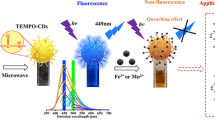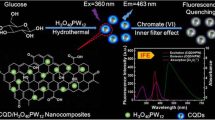Abstract
A nanocomposite was prepared by loading UiO-67 nanoparticles onto porous carbon materials derived from Ce-MOF (Ce-PC) for fluorescence detection of glyphosate. The probe (UiO-67/Ce-PC) exhibits fluorescence emission at 414 nm as the response signal under excitation at 310 nm. The fluorescence enhancement mode of UiO-67 reduces the background interference, and the introduction of Ce-PC provide hierarchical nanostructure and large specific surface area that can increase the contact availability and improve the pre-enrichment effect, ensuring UiO-67/Ce-PC with superior sensitivity. The abundant metal hydroxyl group (M–O-H) of UiO-67/Ce-PC could recognize phosphoryl groups (-PO3H2) of glyphosate through ligand exchange, which synergizes with H-bonding interaction and electrostatic attraction to exhibit specificity toward glyphosate. The competitive coordination effects weaken the ligand-to-metal charge transfer (LMCT) and consequently induce the fluorescence recovery. The calibration plot of the fluorescence enhancement response of UiO-67/Ce-PC towards glyphosate was recorded in the range 0.02–30 μg mL−1 with a low limit of detection (LOD) of 0.0062 μg mL−1, which is superior to the pure UiO-67. In addition, the sensor exhibited high selectivity and satisfactory accuracy and precision with recoveries of 92.1–105.6% and RSDs below 3.4%. This work not only presents a feasible sensor for sensitive and selective determination of glyphosate from cereal samples, but also provides a promising strategy for the design of MOF-based nanocomposites to achieve trace detection of various pollutants.
Graphical abstract






Similar content being viewed by others
References
Valle AL, Mello FCC, Alves-Balvedi RP, Rodrigues LP, Goulart LR (2019) Glyphosate detection: methods, needs and challenges. Environ Chem Lett 17:291–317. https://doi.org/10.1007/s10311-018-0789-5
Zhao J, Pacenka S, Wu J, Richards BK, Steenhuis T, Simpson K, Hay AG (2018) Detection of glyphosate residues in companion animal feeds. Environ Pollut 234:1113–1118. https://doi.org/10.1016/j.envpol.2018.08.100
Zhang Y, Dang YM, Lin XH, An K, Li JP, Zhang MY (2020) Determination of glyphosate and glufosinate in corn using multi-walled carbon nanotubes followed by ultra high performance liquid chromatography coupled with tandem mass spectrometry. J Chromatogr A 1619:460939. https://doi.org/10.1016/j.chroma.2020.460939
Chiarello M, Jiménez-Medina ML, Saéz JM, Moura S, Frenich AG, González RR (2019) Fast analysis of glufosinate, glyphosate and its main metabolite, aminomethylphosphonic acid, in edible oils, by liquid chromatographycoupled with electrospray tandem mass spectrometry. Food Addit Contam A 36:1376–1384. https://doi.org/10.1080/19440049.2019.1631493
Ding SC, Lyu ZY, Li SQ, Ruan XF, Fei MG, Zhou Y, Niu XH, Zhu WL, Du D, Lin YH (2021) Molecularly imprinted polypyrrole nanotubes based electrochemical sensor for glyphosate detection. Biosens Bioelectron 191:113434. https://doi.org/10.1016/j.bios.2021.113434
Stavra E, Petrou PS, Koukouvinos G, Economou A, Goustouridis D, Misiakos K, Raptis I, Kakabakos SE (2020) Fast, sensitive and selective determination of herbicide glyphosate in water samples with a white light reflectance spectroscopy immunosensor. Talanta 214:120854. https://doi.org/10.1016/j.talanta.2020.120854
Wang XF, Yang YX, Huo DQ, Ji Z, Ma Y, Luo HB, Luo XG, Hou CJ, Lv JY (2020) A turn-on fluorescent nanoprobe based on N-doped silicon quantum dots for rapid determination of glyphosate. Microchim Acta 187:341. https://doi.org/10.1007/s00604-020-04304-9
Yang YX, Hou JZ, Huo DQ, Wang XF, Li JW, Xu GL, Bian MH, He Q, Hou CJ, Yang M (2019) Green emitting carbon dots for sensitive fluorometric determination of cartap based on its aggregation effect on gold nanoparticles. Microchim Acta 186:259. https://doi.org/10.1007/s00604-019-3361-5
Karthik P, Pandikumar A, Preeyanghaa M, Kowsalya M, Neppolian B (2017) Amino-functionalized MIL-101(Fe) metal-organic framework as a viable fluorescent probe for nitroaromatic compounds. Microchim Acta 184:2265–2273. https://doi.org/10.1007/s00604-017-2215-2
Huo YP, Liu S, Gao ZX, Ning BA, Wang Y (2021) State-of-the-art progress of switch fluorescence biosensors based on metal-organic frameworks and nucleic acids. Microchim Acta 188:168. https://doi.org/10.1007/s00604-021-04827-9
Zhu XY, Li B, Yang J, Li YS, Zhao WR, Shi JL, Gu JL (2015) Effective adsorption and enhanced removal of organophosphorus pesticides from aqueous solution by Zr-based MOFs of UiO-67. Acs Appl Mater Inter 7:223–231. https://doi.org/10.1021/am5059074
Yang H, Wang B, Cheng J, Wang RG, Zhang S, Dong SJ, Wei SL, Wang PL, Li JR (2019) Determination and removal of clenbuterol with a stable fluorescent zirconium(IV)-based metal organic framework. Microchim Acta 186:454. https://doi.org/10.1007/s00604-019-3586-3
Sekhon SS, Park JS (2021) Biomass-derived N-doped porous carbon nanosheets for energy technologies. Chem Eng J 425:129017. https://doi.org/10.1016/j.cej.2021.129017
Wu BL, Irene MC (2020) Surface functional group engineering of CeO2 particles for enhanced phosphate adsorption. Environ Sci Technol 54:4601–4608. https://doi.org/10.1021/acs.est.9b06812
Wang Y, Xie X, Chen X, Huang C, Yang S (2020) Biochar-loaded Ce3+-enriched ultra-fine ceria nanoparticles for phosphate adsorption. J Hazard Mater 396:122626. https://doi.org/10.1016/j.jhazmat.2020.122626
Cao Y, Wang LN, Shen C, Wang CY, Hu XY, Wang GX (2019) An electrochemical sensor on the hierarchically porous Cu-BTC MOF platform for glyphosate determination. Sensor Actuat B-Chem 283:487–494. https://doi.org/10.1016/j.snb.2018.12.064
Dong WF, Huang YM (2020) CeO2/C nanowire derived from a cerium(III) based organic framework as a peroxidase mimic for colorimetric sensing of hydrogen peroxide and for enzymatic sensing of glucose. Microchim Acta 187:11. https://doi.org/10.1007/s00604-019-4032-2
Chen GZ, Guo ZY, Zhao W, Gao DW, Li CC, Ye C, Sun GX (2017) Design of porous/hollow structured ceria by partial thermal decomposition of Ce-MOF and selective etching. Acs Appl Mater Inter 9:39594–39601. https://doi.org/10.1021/acsami.7b11916
Zhang XX, Zhang WJ, Li G, Liu QQ, Xu YS, Liu X (2020) A ratiometric fluorescent probe for determination of the anthrax biomarker 2,6-pyridinedicarboxylic acid based on a terbium(III)− functionalized UiO-67 metal-organic framework. Microchim Acta 187:122. https://doi.org/10.1007/s00604-020-4113-2
Bansal P, Chaudhary GR, Mehta SK (2015) Comparative study of catalytic activity of ZrO2 nanoparticles for sonocatalytic and photocatalytic degradation of cationic and anionic dyes. Chem Eng J 280:475–485. https://doi.org/10.1016/j.cej.2015.06.039
Yang XM, Zhuo Y, Zhu SS, Luo YW, Feng YZ, Dou Y (2014) Novel and green synthesis of high-fluorescent carbon dots originated from honey for sensing and imaging. Biosens Bioelectron 60:292–298. https://doi.org/10.1016/j.bios.2014.04.046
Lian JJ, Liu P, Jin CQ, Shi ZQ, Luo XL, Liu QY (2019) Perylene diimide-functionalized CeO2 nanocomposite as a peroxidase mimic for colorimetric determination of hydrogen peroxide and glutathione. Microchim Acta 186:332. https://doi.org/10.1007/s00604-019-3439-0
Liu ZQ, Yang L, Sharma AS, Chen M, Chen QS (2019) A system composed of polyethylenimine-capped upconversion nanoparticles, copper(II), hydrogen peroxide and 3,3’,5,5’-tetramethylbenzidine for colorimetric and fluorometric determination of glyphosate. Microchim Acta 186:835. https://doi.org/10.1007/s00604-019-3936-1
Jiang R, Pang YH, Yang QY, Wan CQ, Shen XF (2022) Copper porphyrin metal-organic framework modified carbon paper for electrochemical sensing of glyphosate. Sens Actuators B Chem. https://doi.org/10.1016/j.snb.2022.131492
Surapong N, Burakham R (2021) Magnetic molecularly imprinted polymer for the selective enrichment of glyphosate, glufosinate, and aminomethylphosphonic acid prior to high-performance liquid chromatography. ACS Omega 6:27007–27016. https://doi.org/10.1021/acsomega.1c03488
Julia JL, Eulogio LM, Pilar OB, Antonio RM (2018) Multicommutated flow system for the determination of glyphosate based on its quenching effect on CdTe-quantum dots fluorescence. Food Anal Methods 11:1840–1848. https://doi.org/10.1007/s12161-018-1192-3
Fei Qu, Wang H, You J (2020) Dual lanthanide-probe based on coordination polymer networks for ratiometric detection of glyphosate in food samples. Food Chem 323:126815–126822. https://doi.org/10.1016/j.foodchem.2020.126815
Nguyen VT, Nguyen TB, Chen CW, Hung CM, Vo TDH, Chang JH, Dong CD (2019) Influence of pyrolysis temperature on polycyclic aromatic hydrocarbons production and tetracycline adsorption behavior of biochar derived from spent coffee ground. Bioresource Technol 284:197–203. https://doi.org/10.1016/j.biortech.2019.03.096
Zhu XY, Gu JL, Wang Y, Li B, Li YS, Zhao WR, Shi JL (2014) Inherent anchorages in UiO-66 nanoparticles for efficient capture of alendronate and its mediated release. Chem Commun 50:8779–8782. https://doi.org/10.1039/C4CC02570A
Su P, Du XD, Zheng Y, Fu WY, Zhang QZ, Zhou MH (2021) Interface-confined multi-layered reaction centers between Ce-MOFs and Fe3O4@C for heterogeneous electro-Fenton at wide pH 3–9: Mediation of Ce3+/Ce4+ and oxygen vacancy. Chem Eng J. https://doi.org/10.1016/j.cej.2021.133597
Molinari M, Symington AR, Sayle DC, Sakthivel TS, Seal S, Parker SC (2019) Computer-aided design of nanoceria structures as enzyme mimetic agents: the role of bodily electrolytes on maximizing their activity. ACS Appl Bio Mater 2:1098–1106. https://doi.org/10.1021/acsabm.8b00709
Young GK, Taegu D, Chun YS, Kim CH, Choi US, Kim JY (2016) CeO2-covered nanofiber for highly efficient removal of phosphorus from aqueous solution. J Hazard Mater 307:91–98. https://doi.org/10.1016/j.jhazmat.2015.12.060
Yang J, Dai Y, Zhu XY, Wang Z, Li YS, Zhuang QX, Shi JL, Gu JL (2015) Metal–organic frameworks with inherent recognition sites for selective phosphate sensing through their coordination-induced fluorescence enhancement effect. J Mater Chem A 3:7445–7452. https://doi.org/10.1039/C5TA00077G
Hu XF, Li YL, Miao AZ, Deng CH (2020) Dual metal cations coated magnetic mesoporous silica probe for highly selective capture of endogenous phosphopeptides in biological samples. Microchim Acta 187:400. https://doi.org/10.1007/s00604-020-04323-6
Funding
This work is supported by the National Natural Science Foundation of China (No. 32172327, 32060571) and the Innovation Foundation of University in Gansu Province (2021A-123).
Author information
Authors and Affiliations
Contributions
Yu Qiang: methodology, software, investigation, formal analysis, writing—original draft, review and editing. Weixia Yang: methodology and investigation. Xiaoshuo Zhang: data curation. Xueli Luo: project administration and software. Wenzhi Tang and Tianli Yue: supervision and software. Zhonghong Li: conceptualization, writing—review and editing, funding, acquisition, validation.
Corresponding author
Ethics declarations
Competing interests
The authors declare no competing interests.
Additional information
Publisher's note
Springer Nature remains neutral with regard to jurisdictional claims in published maps and institutional affiliations.
Supplementary Information
Below is the link to the electronic supplementary material.
Rights and permissions
About this article
Cite this article
Qiang, Y., Yang, W., Zhang, X. et al. UiO-67 decorated on porous carbon derived from Ce-MOF for the enrichment and fluorescence determination of glyphosate. Microchim Acta 189, 130 (2022). https://doi.org/10.1007/s00604-022-05236-2
Received:
Accepted:
Published:
DOI: https://doi.org/10.1007/s00604-022-05236-2




